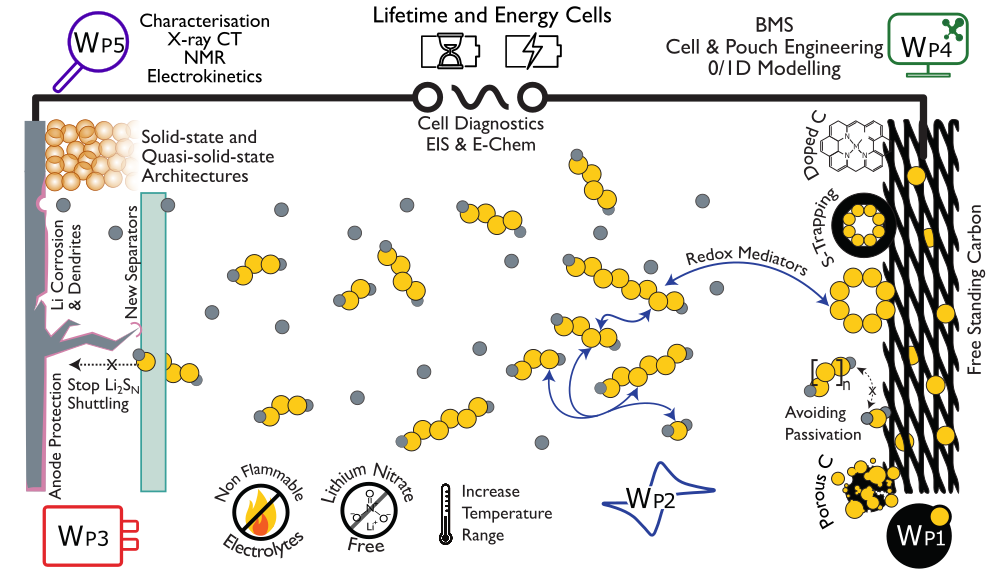LiSTAR, the Lithium-Sulfur Technology Accelerator, is one of the ten Faraday Institution projects, which aim to place the UK at the forefront of the global battery revolution. The project is a collaboration, led by UCL, of eight university and multiple industrial partners, each bringing unique capabilities to the development of Li-S batteries, from materials discovery to system engineering.
Composed of five parallel work streams, each tackling fundamental challenges relating to the development of Li-S batteries, the WPs and structure of LiSTAR is shown in this diagram.
Cathodes
Building upon the existing expertise in LiSTAR, WP1 will cement the development of Li-S cathodes based upon:
Electrospun
Transition Metal Dichalcogenides
S/C composites
Within this WP is an effort to develop scientific reasoning and understanding behind the methods of scale up to ensure the work conducted has the potential for direct industrial impact. The WP is supported by modelling efforts which span WP’s 1,2 & 3 and Characterisation efforts housed in WP5.
Electrolytes & Electrochemistry
Removing LiNO3 is amongst the remaining barriers to commercialisation for Li-S cells. In this Work Package researchers will work to develop new electrolyte formulations and active additives to improve the sulfur utilisation, lifetime and rate performance of the cells and enable sufficient cycling without the presence of LiNO3.
This Work Package will also support modelling efforts which span WP’s 1,2 & 3 and be supported by the Characterisation efforts housed in WP5, in particular the characterisation of the electrokinetics, electrolyte and NMR work which will provide scientific insight into the developments achieved in WP2.
Anodes and New Cell Concepts
Whilst there is substantial scope to develop conventional liquid-electrolyte Li-S cells which operate through polysulfide conversion there are several cell approaches that may enable the challenges associate with this to be circumvented. While still in a relatively nascent stage of development these novel cell concepts hold significant promise.
In this Work Package a protected Li metal anode will be developed whilst all-solid and quasi-solid state cell concepts will be explored and developed. These approaches decouple the Li metal anode from polysulfides enabling more facile routes to extended lifetime however will require substantial development using a whole cell approach.
The WP is supported by modelling efforts which span WP’s 1,2 & 3 and Characterisation efforts housed in WP5 which enable a more dynamic response across the programme.
Cell and System Engineering
As part of Phase 2, the LiSTAR programme will retain the capability to produce pouch cells of 5 Ah scale to ensure this demonstration is possible. In addition this work will provide key metrics for scale up which can be tested in the lab to minimise the challenges in scale up and provide benchmark electrodes and cells to facilitate the development of BMS’s and diagnostic techniques. The transition to Li-S pouch cells has unique challenges associated with the electrolyte/electrode interactions, which must be facilitated with reduced electrolyte volume.
This WP will also develop an understanding of the formulation methods and rheology of slurries to ensure the viability of developments across the project. Finally, 0/1D modelling activities will continue to accurately represent the behaviour of Li-S systems, expanded to degradation modes and temperature/rate dependencies.
Li-S Characterisation
This WP has been designed to ensure the Li-S specific characterisation tools which have and will be developed during LiSTAR provide the maximum impact for researchers and enable the broadest understanding of the evolution of components and the mechanisms through which these degradation and aging modes occur.
The WP will aim to develop specific Li-S characterisation approaches to investigate the evolution of components and the specifics of mechanisms across the cell. By combining these methods we aim to develop a shared approach to encourage the combination of techniques to maximise the insights gained. The WP will predominantly support WP’s 1-3.






